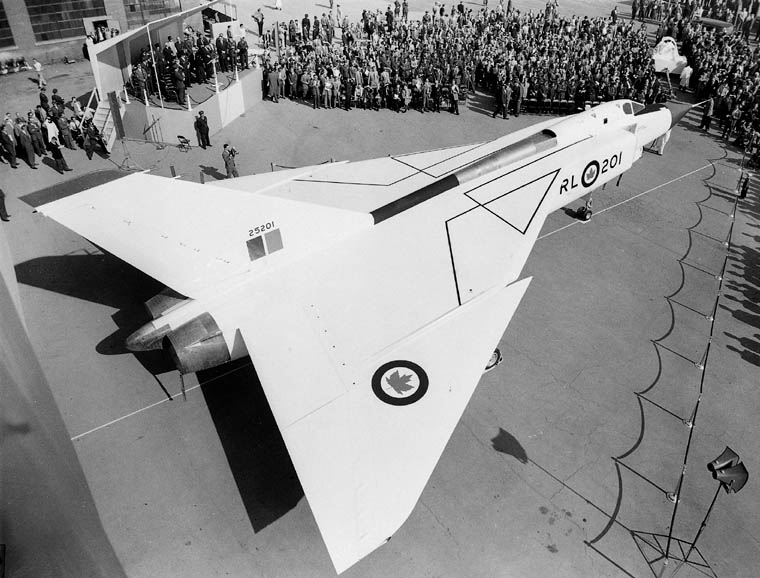CF-105 Arrow: The Amazing Jet Designed to Fight Russia (Not from America)
Development of the CF-105 initially progressed quickly. It was one of the most advanced aircraft of its day, but it was also widely praised for its power and beauty. The Arrow helped to establish Canada as a world leader in scientific research and development.
For more than a decade, a team of volunteers at an aviation museum outside of Calgary have been slowly but meticulously constructing a 60 percent scale replica of a supersonic interceptor jet – one that never actually entered service.
It would seem a strange endeavor, yet, the Avro Museum, which grew out of a non-profit group founded more than 25 years ago, spent eight years researching to ensure that every facet of the replica was as close to the actual aircraft as possible.
As of November 2023, around 70 percent of the model airframe has been completed, while the project is just under halfway finished. When it is completed, it will cost around $1.5 million.
The Avro Museum is hardly the only institution so enamored with this particular aircraft – namely the Avro Arrow CF-105.
Another replica – one built to full scale – is now the centerpiece of the Canadian Air and Space Conservancy – formerly the Toronto Aerospace Museum. The URL for that museum is even avroarrow203.com!
In addition, a 1997 four-hour TV miniseries about the Arrow program was produced for CBC Television and it went on to have the highest viewership to that point for a CBC program. Tilted simply "The Arrow," it starred notable Canadian actors including Dan Aykroyd, Michael Ironside, and Sara Botsford while it offered a dramatized look at the attempt to produce the supersonic jet that was developed during the early stages of the Cold War.
Canadians clearly have a special place in their hearts for the CF-105.
Origins of the Arrow
Following the Second World War, there were very valid concerns that the Soviet bombers could attack North America via the Canadian Arctic – and NATO intelligence even suggested such a strike could come as early as 1954.
However, the British Royal Air Force (RAF) was still recovering and had no money to think about a new interceptor. At the same time, A.V. Roe set up shop in Canada to take advantage of the country's skilled aviation labor force that had been left unemployed following the Second World War. The company — newly branded A.V. Roe Canada — was established in the Malton area of Mississauga, Ontario, at the former Victory Aircraft plant
Avro Canada, as it was soon rebranded, went on to develop the CF-100, often dubbed the "Canuck."
As the first combat aircraft of all-Canadian design, it proved to be an excellent long-range, all-weather fighter. More importantly, it highlighted that the newly formed Avro Canada – an offshoot of the British-based aircraft manufacturer – showed brilliance in completing a challenging project quickly.

From that success, in the mid-1950s, work progressed on the Avro Canada CF-105 Arrow, a giant, delta-winged interceptor. It offered a bright hope for the future of the Canadian aircraft industry and had the potential of providing the Royal Canadian Air Force (RCAF) with the capability to meet Soviet bombers from as far away as the North Pole.
After earning the right to develop and build the aircraft, Avro Canada grew significantly, and by 1957, employed more than 20,000 people – making it one of the largest companies in the nation. It also drew major investment from the government as well as from its own employees.
Confidence in the company, and Canada's aerospace industry, was soaring high. Unfortunately, it wasn't to last.
The CF-105 Was Massive – Perhaps Too Massive
Development of the CF-105 initially progressed quickly. It was one of the most advanced aircraft of its day, but it was also widely praised for its power and beauty. The Arrow helped to establish Canada as a world leader in scientific research and development.

Yet, it was an immense project in size, scale, and ambition.
The aircraft itself was enormous; weighing about 20,000 kg (44,000 pounds) empty, with a 15.2 meter (50 feet) wingspan. It was a huge aircraft for an interceptor and was nearly as large as some bombers of the era. It was cutting-edge and required many of its components to be specially developed.
The Arrow boasted the world's first computerized flight control and weapon system, while it was faster than any jet in its class. The interceptor was designed to travel at nearly twice the speed of sound at an altitude of 53,000 feet. Developed without the aid of computers or simulation tools, the designers relied on scale models for wind tunnel testing.
Rolled Out, and Then Canceled
The first CF-105 Arrow prototype was rolled out on October 4, 1957 – and more than 12,000 people arrived to see the advanced-looking aircraft. However, that event was largely overshadowed on the world stage by the USSR's launch of Sputnik 1 into orbit on that same day – which heralded the dawn of the space age and potentially the end of the Arrow's main target, the long-range bomber.
A total of five Arrows took part in flight tests in a program that began in 1958, but the project was doomed due to political and technical woes.
The high cost of the program was one factor, but a newly released report from September 2023 also found that the Soviet Union's shift away from manned bombers to long-range ballistic missiles doomed the aircraft.
Interceptors like the Arrow would simply play a smaller role in the defense of North America.
There were also internal fears within the Canadian military that the CF-100 would be outclassed by newer Soviet bombers operating at higher altitudes and flying at faster speeds.
As a result, the program was canceled in February 1959 by the government of the newly elected Canadian Prime Minister John Diefenbaker, who sought to cut federal spending. It likely didn't help that Diefenbaker, a Progressive Conservative and teetotaler, had a poor relationship with Avro Canada's President Crawford Gordon, Jr., who was known for his love of smoke and drink.
Diefenbaker announced the cancellation of the Arrow in the House of Commons in February 1959, citing the changing strategic threat as the main reason.
The Avro Canada CF-105 never entered production, and the RCAF eventually acquired the American-built CF-101B Voodoo instead. Avro Canada never recovered from the program's cancellation and ceased operations in 1962.
Though the prototypes were not saved from the scrapyard, there have been efforts by fans of the jet to ensure its legacy lives on.
Author Experience and Expertise
A Senior Editor for 19FortyFive, Peter Suciu is a Michigan-based writer. He has contributed to more than four dozen magazines, newspapers, and websites with over 3,200 published pieces over a twenty-year career in journalism. He regularly writes about military hardware, firearms history, cybersecurity, politics, and international affairs. Peter is also a Contributing Writer for Forbes and Clearance Jobs. You can follow him on Twitter: @PeterSuciu.
Image Credit: Creative Commons.


